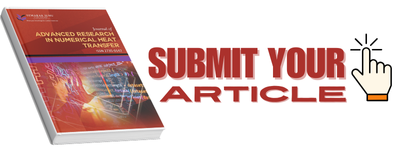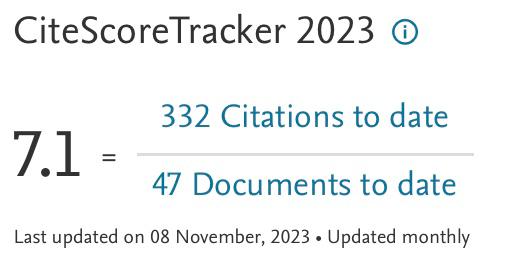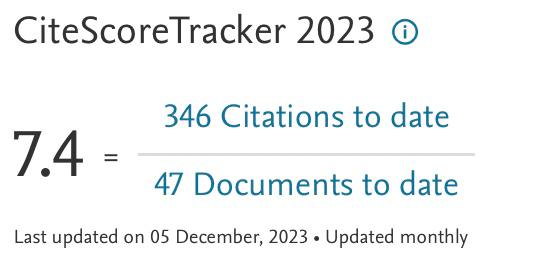CFD Analysis of Indoor Ventilation for Airborne Virus Infection
DOI:
https://doi.org/10.37934/arnht.14.1.116Keywords:
Infection prevention, Ventilation, CFD, Residence time, AerosolsAbstract
CFD Analysis of Indoor Ventilation for Airborne Virus Infection
Indoor airflow patterns and air residence times significantly influence the spread of airborne infectious viruses, such as COVID-19. These factors can be quantified using computational fluid dynamics (CFD). In this study, CFD was utilized to assess the indoor airflow patterns and calculate air residence times in a typical restroom with high personnel flow and low ventilation efficiency. The results identified regions with high air residence times, indicating potential risk areas for airborne virus retention. Furthermore, the effects of different ventilation strategies on these high-risk areas were analyzed. Despite meeting air change standards, certain regions were found to potentially pose a higher risk due to prolonged air residence times. Based on these findings, recommendations for improving ventilation systems to reduce the risk of airborne virus infection were proposed. This study highlights the necessity of a more nuanced approach to indoor air assessment than simply calculating air changes per hour. It was concluded that (1) different ventilation strategies can greatly affect the air residence time in the room and (2) the variance of air residence time in the air circulation area are large in some locations, even with simple ventilation adjustments.
Downloads
References
Sinha, Krishnendu, Mani Shankar Yadav, Rajasekharan Jayakrishnan, Guruswamy Kumaraswamy, Janani Srree Murallidharan, and Vivek Kumar. "Field experiments to identify and eliminate recirculation zones to improve indoor ventilation: Comparison with cfd." Transactions of the Indian National Academy of Engineering 7, no. 3 (2022): 911-926. https://doi.org/10.1007/s41403-022-00335-1
Bhagat, Rajesh K., MS Davies Wykes, Stuart B. Dalziel, and P. F. Linden. "Effects of ventilation on the indoor spread of COVID-19." Journal of Fluid Mechanics 903 (2020): F1. https://doi.org/10.1017/jfm.2020.720
Bolashikov, Zhecho D., Arsen K. Melikov, Wojciech Kierat, Zbigniew Popiołek, and Marek Brand. "Exposure of health care workers and occupants to coughed airborne pathogens in a double-bed hospital patient room with overhead mixing ventilation." Hvac&R Research 18, no. 4 (2012): 602-615.
Dbouk, Talib, and Dimitris Drikakis. "On airborne virus transmission in elevators and confined spaces." Physics of Fluids 33, no. 1 (2021). https://doi.org/10.1063/5.0038180
Ji, Xiaolin, Olivier Le Bihan, Olivier Ramalho, Corinne Mandin, Barbara D’Anna, Laurent Martinon, Mélanie Nicolas, Denis Bard, and J‐C. Pairon. "Characterization of particles emitted by incense burning in an experimental house." Indoor Air 20, no. 2 (2010): 147-158. https://doi.org/10.1111/j.1600-0668.2009.00634.x
Wang, Haitao, Miaoda Lin, and Yan Chen. "Performance evaluation of air distribution systems in three different China railway high-speed train cabins using numerical simulation." In Building simulation, vol. 7, pp. 629-638. Springer Berlin Heidelberg, 2014. https://doi.org/10.1007/s12273-014-0168-5
Singer, Brett C., Haoran Zhao, Chelsea V. Preble, William W. Delp, Jovan Pantelic, Michael D. Sohn, and Thomas W. Kirchstetter. "Measured influence of overhead HVAC on exposure to airborne contaminants from simulated speaking in a meeting and a classroom." Indoor air 32, no. 1 (2022): e12917. https://doi.org/10.1111/ina.12917
Yin, Yonggao, Jitendra K. Gupta, Xiaosong Zhang, Junjie Liu, and Qingyan Chen. "Distributions of respiratory contaminants from a patient with different postures and exhaling modes in a single-bed inpatient room." Building and environment 46, no. 1 (2011): 75-81. https://doi.org/10.1016/j.buildenv.2010.07.003
Sinha, Krishnendu, Mani Shankar Yadav, Utkarsh Verma, Janani Srree Murallidharan, and Vivek Kumar. "Effect of recirculation zones on the ventilation of a public washroom." Physics of Fluids 33, no. 11 (2021). https://doi.org/10.1063/5.0064337
Zhang, Zhihang, Taehoon Han, Kwang Hee Yoo, Jesse Capecelatro, André L. Boehman, and Kevin Maki. "Disease transmission through expiratory aerosols on an urban bus." Physics of Fluids 33, no. 1 (2021). https://doi.org/10.1063/5.0037452
Kassem, Fatma AbdelMordy, Ahmed Farouk AbdelGawad, Ali Elsayed Abuel-Ezz, Mofreh Melad Nassief, and Mohamed Adel. "Design and Performance Evaluation of a Portable Chamber for Prevention of Aerosol Airborne–Infection." Journal of Advanced Research in Fluid Mechanics and Thermal Sciences 100, no. 2 (2022): 181-197. https://doi.org/10.37934/arfmts.100.2.181197
Kohanski, Michael A., L. James Lo, and Michael S. Waring. "Review of indoor aerosol generation, transport, and control in the context of COVID‐19." In International forum of allergy & rhinology, vol. 10, no. 10, pp. 1173-1179. 2020. https://doi.org/10.1002/alr.22661
Noorimotlagh, Zahra, Neemat Jaafarzadeh, Susana Silva Martínez, and Seyyed Abbas Mirzaee. "A systematic review of possible airborne transmission of the COVID-19 virus (SARS-CoV-2) in the indoor air environment." Environmental research 193 (2021): 110612. https://doi.org/10.1016/j.envres.2020.110612
Rowe, Bertrand R., André Canosa, Jean-Michel Drouffe, and James Brian Alexander Mitchell. "Simple quantitative assessment of the outdoor versus indoor airborne transmission of viruses and COVID-19." Environmental research 198 (2021): 111189. https://doi.org/10.1016/j.envres.2021.111189
Bazant, Martin Z., Ousmane Kodio, Alexander E. Cohen, Kasim Khan, Zongyu Gu, and John WM Bush. "Monitoring carbon dioxide to quantify the risk of indoor airborne transmission of COVID-19." Flow 1 (2021): E10. https://doi.org/10.1017/flo.2021.10
Habeebullah, Turki M., Ibrahim HA Abd El-Rahim, and Essam A. Morsy. "Impact of outdoor and indoor meteorological conditions on the COVID-19 transmission in the western region of Saudi Arabia." Journal of environmental management 288 (2021): 112392. https://doi.org/10.1016/j.jenvman.2021.112392
Li, Yun-yun, Ji-Xiang Wang, and Xi Chen. "Can a toilet promote virus transmission? From a fluid dynamics perspective." Physics of Fluids 32, no. 6 (2020). https://doi.org/10.1063/5.0013318
Toja-Silva, Francisco, Jia Chen, Stephan Hachinger, and Frank Hase. "CFD simulation of CO2 dispersion from urban thermal power plant: Analysis of turbulent Schmidt number and comparison with Gaussian plume model and measurements." Journal of Wind Engineering and Industrial Aerodynamics 169 (2017): 177-193. https://doi.org/10.1016/j.jweia.2017.07.015
Rosti, M. E., S. Olivieri, M. Cavaiola, A. Seminara, and A. Mazzino. "Fluid dynamics of COVID-19 airborne infection suggests urgent data for a scientific design of social distancing." Scientific reports 10, no. 1 (2020): 22426. https://doi.org/10.1038/s41598-020-80078-7
Yang, Wan, and Linsey C. Marr. "Mechanisms by which ambient humidity may affect viruses in aerosols." Applied and environmental microbiology 78, no. 19 (2012): 6781-6788. https://doi.org/10.1038/s41598-020-80078-7
Yang, Wan, and Linsey C. Marr. "Dynamics of airborne influenza A viruses indoors and dependence on humidity." PloS one 6, no. 6 (2011): e21481. https://doi.org/10.1371/journal.pone.0021481
Benbough, J. E. "Some factors affecting the survival of airborne viruses." Journal of General Virology 10, no. 3 (1971): 209-220. https://doi.org/10.1099/0022-1317-10-3-209
Lednicky, John A., Michael Lauzardo, Md M. Alam, Maha A. Elbadry, Caroline J. Stephenson, Julia C. Gibson, and J. Glenn Morris Jr. "Isolation of SARS-CoV-2 from the air in a car driven by a COVID patient with mild illness." International Journal of Infectious Diseases 108 (2021): 212-216. https://doi.org/10.1016/j.ijid.2021.04.063




























